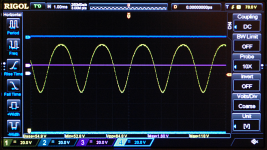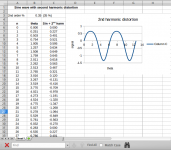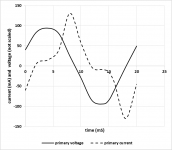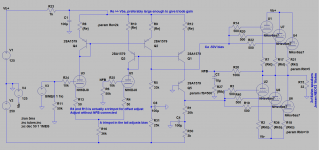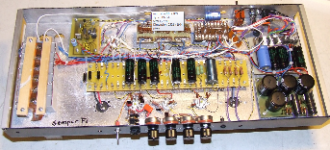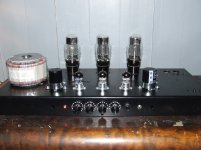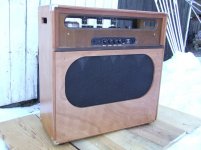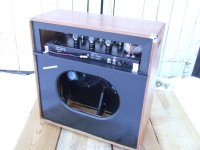Thank you, JMD.
I also like Atmasphere's use of 4 x series drivers. I thought about that wasn't sure whether series LF resonance was an issue. I read somewhere here that the resonance doesn't get 'worse' because the other characteristics maintain the same proportions.
I guess "just do it".
I also like Atmasphere's use of 4 x series drivers. I thought about that wasn't sure whether series LF resonance was an issue. I read somewhere here that the resonance doesn't get 'worse' because the other characteristics maintain the same proportions.
I guess "just do it".
Last edited:
Definitely NOT in *guitar amp* duty 😉OTLs most definitely sound like tube amps!
Will your overdriven OTL amp make *this* waveform?
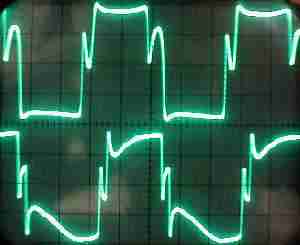
or this?
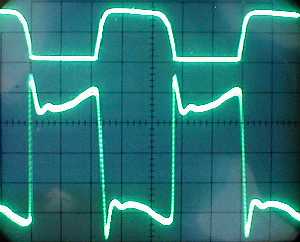
or this?
An externally hosted image should be here but it was not working when we last tested it.
not much chance of that.
This is turning out to be quite a fascinating thread!
What I find with many commercial amplifiers is that cheeping out on the transformers leads to thin bass and poor articulation. They typically use larger cap values within the amp to increase bass, resulting in an overall flabby low end and mushy distortion tones. It's really essential to keep low end carefully controlled all the way up to the power amplifier. So I came to learn that transformers are the starting point for voicing an amplifier.
A couple of great classic amplifiers I've had dealings with are the Marshall 18W and the HiWatt DR amps. The Marshall 18W has a design "influenced" (cough cough) by the Watkins Dominator, and featured a very nice budget Hi-Fi OT from RS, built for use with the Mullard 5-10. So no wonder the 18W has superb tone all the way across the guitar frequency range, and is so popular with guitarists. The Hiwatts were extremely well engineered amps, based on an original design by their late founder, Dave Reeves. The Hiwatt design philosophy (and build quality) might as well be from a different planet than Fender/Marshall/Vox. A key part of their tone and dynamic are the transformers - a PT with little sag and a Partridge OT with a pretty flat response from 3.6Hz to 112KHz. 😎
CONCLUSION: To get back to OTL amps, what I'm basically saying here is that a crappy OT isn't necessarily desirable for a guitar amp. And I would suggest that no OT at all is probably going to be better than having a cheap OT, like so many commercial guitar amplifiers (unless you only ever play blues). However, if cost isn't an issue, my own preference would still be to have a good quality OT over OTL.
Same here 🙂 Although, I was actually just a designer, rather than being the company myself.I have been a professional guitar amp manufacturer for some years ( and still I'm building them for friends or myself).
Some good solid tone there, although I also think I hear some high-end sharpness, which could probably be tamed with a "dull cap" or two in the circuit. Perhaps it's just an artifact of YouTue's not great audio quality. I bet this would also make a really great amp for Nu-Metal, which needs a lot of both highs and lows.
Yes, there's plenty of those folk around, and even those that put carbon comp resistors into FX pedals! This article goes into some of the science related to that - http://www.geofex.com/Article_Folders/carbon_comp/carboncomp.htmI've run into those that maintained that cheap carbon composition resistors are the trick parts for a guitar amp.
That's a great idea! And as we know there are benefits to driving power tube grids with an interstage.At any rate, if you want to add ferro-magnetics as a coloration to the sound of an OTL, its easy to do without using an output transformer! All you have to do is get a cheap interstage transformer and you're all set.
That's a sheer work of art! 😎The amp I built can be seen on the Atma-Sphere facebook page.
Exactly!I have heard this many times, and I do believe it's quite plausible. The logic being, "tone" actually is a misnomer for "timbre" in this context, and anything that creates roughly 10% or more harmonic distortion has the potential to change the timbre.
From my years of designing and building guitar amps on a professional/commercial basis, I found in countless cases that transformers (both OT & PT) have a massive effect on the tonal signature of an amp. A major part of amplifier development is to lend prototypes to professional players and recording studios, who would know very little about inner workings of what they were trying out. Their feedback (pardon the pun) would play an essential part in getting the amplifier voiced optimally, and they would not hold back from saying what they did or didn't like. It was very obvious that transformers had a huge effect on an amp's tone and dynamics.So it's certainly plausible that the output transformer contributes to guitar amp "tone". But it bothers me that I've never heard of anyone actually doing an experiment to prove it.
Agreed again! As we also know, higher power guitar amps usually have SS rectification. However, many people overlook the considerable sag which comes from the PT itself, which is very easy to measure on the bench.I agree totally that "sag" is very much a part of guitar amps designed for at least some genres of guitar music. But I think "sag" is more like building an accidental compressor into the circuit. Not quite the same as creating THD because of a nonlinearity in the transfer function.
Yes, I've seen that one too! Mr Crowhurst really didn't like guitar amps or rock music. 🙂 But I believe he's very right. Especially in his day, many guitar amps had really horrible OTs, often repurposed from cheap consumer electronics. We can debate whether saturation was really an issue (or maybe just do the math in the case of a Fender Champ 6V6 power stage), but OTs like that can really degrade the sound from a hifi perpective, through both their poor frequency and transient responses (see the waveforms posted by JHMFahey). Of course that degradation would give you a very charming and warm blues amp, but with not a lot of dynamics or string definition. In other words, pretty much a one-trick pony. However, most guitarists these days are looking for more versatile amplifiers with a tight, firm low end and crisp, articulate highs. Whether playing "clean" or distorted, they also want the "valve warmth" to come through - so quite a challenge.With respect to OPT distortion, although a little over my head, it doesn't make sense that a guitar OPT doesn't distort more. They are half the size, and can have massive quality shortcuts such as non-interleaved windings and even windings on separate bobbins.
I came across this by Crowhurst in Audio, March 1957, p. 22:
What I find with many commercial amplifiers is that cheeping out on the transformers leads to thin bass and poor articulation. They typically use larger cap values within the amp to increase bass, resulting in an overall flabby low end and mushy distortion tones. It's really essential to keep low end carefully controlled all the way up to the power amplifier. So I came to learn that transformers are the starting point for voicing an amplifier.
A couple of great classic amplifiers I've had dealings with are the Marshall 18W and the HiWatt DR amps. The Marshall 18W has a design "influenced" (cough cough) by the Watkins Dominator, and featured a very nice budget Hi-Fi OT from RS, built for use with the Mullard 5-10. So no wonder the 18W has superb tone all the way across the guitar frequency range, and is so popular with guitarists. The Hiwatts were extremely well engineered amps, based on an original design by their late founder, Dave Reeves. The Hiwatt design philosophy (and build quality) might as well be from a different planet than Fender/Marshall/Vox. A key part of their tone and dynamic are the transformers - a PT with little sag and a Partridge OT with a pretty flat response from 3.6Hz to 112KHz. 😎
CONCLUSION: To get back to OTL amps, what I'm basically saying here is that a crappy OT isn't necessarily desirable for a guitar amp. And I would suggest that no OT at all is probably going to be better than having a cheap OT, like so many commercial guitar amplifiers (unless you only ever play blues). However, if cost isn't an issue, my own preference would still be to have a good quality OT over OTL.
Personally, I would prefer to use a pair of lower power 16 ohm speakers in series, so that you get a bit more warmth from the speaker(s) working a bit harder. Perhaps even a dissimilar pair, like an Eminence Swamp Thang with a Private Jack. YMMV of course.Hi there m: re post #1, Eminence B810, 32 ohm, 10-inch diameter, 150watts guitar loudspeaker is available from US Speaker for about $70. ...regards, Michael
Last edited:
I agree with Aqua Tarkus that this turned into an interesting thread, and I want to say thank you to everyone who contributed their opinions and/or experience.
And after all of these very interesting posts, we are left with the conclusion that a bad transformer makes a guitar amp sound good. 🙂
No, wait, actually it's a good transformer makes a guitar amp sound good.
No, sorry, what we actually meant to say is that a transformer probably doesn't play much of a role in guitar amp sound, after all. 😛
Man, those Yeti's are hard to pin down long enough to get a clean DNA sample! 😀
I'm still troubled by the same issues Malcolm Irving eloquently described in his post #37. Ideally, we would have one verifiable explanation that simultaneously incorporates answers to the concerns and issues raised by myself, Malcolm Irving, JM Fahey, Aqua Tarkus, Thoglette, and several more people. I don't believe we have that answer yet.
On the plus side, there was a recent thread here about an entirely solid-state guitar amp that attempted to sound rather like a Vox AC30, and which incorporated an output transformer (because the designer believed it was essential to guitar amp sound).
And this thread is about a valve guitar amp that does not have an output transformer, and attempts to sound like, well, a valve guitar amplifier.
So at least we're seeing attempts to uncover the truth from both sides of the belief system. That's a good thing!
-Gnobuddy
And after all of these very interesting posts, we are left with the conclusion that a bad transformer makes a guitar amp sound good. 🙂
No, wait, actually it's a good transformer makes a guitar amp sound good.

No, sorry, what we actually meant to say is that a transformer probably doesn't play much of a role in guitar amp sound, after all. 😛
Man, those Yeti's are hard to pin down long enough to get a clean DNA sample! 😀
I'm still troubled by the same issues Malcolm Irving eloquently described in his post #37. Ideally, we would have one verifiable explanation that simultaneously incorporates answers to the concerns and issues raised by myself, Malcolm Irving, JM Fahey, Aqua Tarkus, Thoglette, and several more people. I don't believe we have that answer yet.
On the plus side, there was a recent thread here about an entirely solid-state guitar amp that attempted to sound rather like a Vox AC30, and which incorporated an output transformer (because the designer believed it was essential to guitar amp sound).
And this thread is about a valve guitar amp that does not have an output transformer, and attempts to sound like, well, a valve guitar amplifier.
So at least we're seeing attempts to uncover the truth from both sides of the belief system. That's a good thing!
-Gnobuddy
Actually I've seen waveforms like that, after I started using an input transformer. And pushing the amp pretty hard.Definitely NOT in *guitar amp* duty 😉 <snip>
The exact shape of the waveform(s) may be a red herring, too. There have been studies that found that scrambling the phase relationship between various harmonics in a square wave produced no change in timbre - though the waveform was scrambled beyond recognition.
And, of course, the school marching band sounds the same whichever side of the road you happen to be standing on, and doesn't change much when you move a half-wavelength further or closer (pick your frequency for the half-wavelength move!) 🙂
Guitar amps are not subtle things in terms of the way they modify the signal passing through them. I think only fairly heavy-duty alternations to the signal are audible in this context.
An example: a couple of years ago I was struggling to achieve a good clean tone with the little guitar amp I was designing and building. I finally succeeded, working blind, without an oscilloscope, using only my ears and a DMM.
Some months later I was able to save up enough to buy a Rigol 'scope, and the attached photo shows what I saw when I looked at my "clean tone". 😱
The second picture shows a simple spreadsheet simulation: a sine wave with about 35% second-harmonic distortion added to it. The result isn't quite identical to the scope capture, but has quite a strong similarity to it.
The surprise for me was finding out just how much 2nd harmonic distortion it took to create a good clean tone. Roughly thirty five percent! 😱
(The guitar tone doesn't sound at all distorted under these conditions. It sounds like a nice "tubey" or "valvey" clean tone, there is no audible harshness or "grit" at all.)
-Gnobuddy
And, of course, the school marching band sounds the same whichever side of the road you happen to be standing on, and doesn't change much when you move a half-wavelength further or closer (pick your frequency for the half-wavelength move!) 🙂
Guitar amps are not subtle things in terms of the way they modify the signal passing through them. I think only fairly heavy-duty alternations to the signal are audible in this context.
An example: a couple of years ago I was struggling to achieve a good clean tone with the little guitar amp I was designing and building. I finally succeeded, working blind, without an oscilloscope, using only my ears and a DMM.
Some months later I was able to save up enough to buy a Rigol 'scope, and the attached photo shows what I saw when I looked at my "clean tone". 😱
The second picture shows a simple spreadsheet simulation: a sine wave with about 35% second-harmonic distortion added to it. The result isn't quite identical to the scope capture, but has quite a strong similarity to it.
The surprise for me was finding out just how much 2nd harmonic distortion it took to create a good clean tone. Roughly thirty five percent! 😱
(The guitar tone doesn't sound at all distorted under these conditions. It sounds like a nice "tubey" or "valvey" clean tone, there is no audible harshness or "grit" at all.)
-Gnobuddy
Attachments
General Electric did a study back in the 1960s that showed that people would tolerate a significant amount of 2nd harmonic (+30%) without complaint.
Thanks for that. I guess they were right! 🙂General Electric did a study back in the 1960s that showed that people would tolerate a significant amount of 2nd harmonic (+30%) without complaint.
I hadn't heard of that particular study, though I know 20% distortion wasn't unusual near the centre of a (vinyl) record, and also occurred frequently in cassette tapes that had been recorded a little too "hot".
With 35% second harmonic in my guitar amp, I could hear some intermodulation (roughness) if I played two or more notes simultaneously. But single notes sounded completely clean. Guitar is not a good source for revealing small amounts of distortion, or, put another way, it takes a lot of distortion to change the sound of a guitar enough for us to notice!
-Gnobuddy
I run an LP mastering operation (scully lathe with Westerex 3D cutter head, Westerex 1700 series electronics)- that kind of distortion in the LP would be some sort of playback problem (probably poor setup). Its certainly not in the grooves!
I think output transformers do affect the sound of a guitar amp. Undersized transformers have a relatively low magnetizing inductance, which limits bass response and causes distortion in the output valves (by only offering them a low impedance inductive load). High frequencies can also be reduced by leakage inductance and intra-winding capacitance.
However, as yet (or as Yeti 😉) I haven't seen any proper evidence of OT saturation in a guitar amp. Clear evidence would consist of a sinusoidal voltage waveform across the OT primary accompanied by the classic saturated current waveform into the primary.
I tried looking for it in some tests on a 5W single-ended amp and was unable to find it - which led me to the line of reasoning outlined in post 37.
However, as yet (or as Yeti 😉) I haven't seen any proper evidence of OT saturation in a guitar amp. Clear evidence would consist of a sinusoidal voltage waveform across the OT primary accompanied by the classic saturated current waveform into the primary.
I tried looking for it in some tests on a 5W single-ended amp and was unable to find it - which led me to the line of reasoning outlined in post 37.
Last edited:
Last edited:
It was "tracing distortion", caused by the difference in shape between the cutting stylus with its razor-sharp edges, and the playback stylus, with its much rounder edges. The difference in geometry means the playback stylus actually does not follow the same path as the cutting stylus, instead flattening out the tips of problematic waveforms in the grooves.that kind of distortion in the LP would be some sort of playback problem (probably poor setup).
The problem is worst for large amplitude high frequencies recorded near the innermost grooves close to the centre of the record. That combination of circumstances - high frequency, high amplitude, low groove linear speed - combines to make for very tight wiggles in the groove, which exaggerates the difference in path between the cutting and playback stylii.
The 20% THD was, I believe, for the traditional conical tip stylus, which was the only profile in use for a long time, before elliptical and hyper-elliptical tips became available.
At least some record manufacturers attempted to pre-distort the groove in the opposite way (widening and deepening the waveform tips), to compensate for the subsequent tracing distortion by a conical stylus, which would blunt them back to the proper shape.Its certainly not in the grooves!
I had one of those LPs once - there was some proprietary name for the pre-distorting process, but I no longer remember what it was.
Pre-distorting could only work if all playback stylii were the same profile, so I would imagine it went out the window when a mix of conical, elliptical, and hyper-elliptical stylii came into use.
-Gnobuddy
^^ Curious.
Between record and playback (using a Technics SL1200 equipped with a Grado Gold) we get about 3% in the inner grooves but we are going from a lathe cut directly to playback.
(we've used OTL amps in this application too)
This is a discussion for a different thread I suspect.
Between record and playback (using a Technics SL1200 equipped with a Grado Gold) we get about 3% in the inner grooves but we are going from a lathe cut directly to playback.
(we've used OTL amps in this application too)
This is a discussion for a different thread I suspect.
Sorry for long response time on the schematic. I still haven’t got the actual schematic of the amp in the video. (I have my work shop some 3hours drive away and am seldom there these days). Here is a sample that shows the idea.
I'm pretty sure I've posted this idea before.
I leave the preamp out since I think only the OTL output section is relevant here. We all tune our preamps anyways. But as mentioned most of the sound is in the pre.
I had a few criteria for myself when I started this project. The main one being:
-Not yet another clone. So no Fender/Marshall based amp, and no circlotron since Atmasphere covers that topology. No Futterman and no Tim Mellows...
This is actually a very flexible circuit.
The folded cascode criminally introduces transistors, but they only mirror the triode's current and I don't think they do much to the sound. They give the possibility of varying the LTP triode’s characteristics. Small emitter resistors and the triode’s plates see a stiff load and they behave more like pentodes. Large emitter resistors (large enough to give gain) gives voltage swing on the plates for some inherent triode-feedback. It lowers the total gain so there’s a limit. Anyways make sure they at least provide Vbe drop (0.7V) so the transistors don’t need to be matched.
The bias is easily set with a potentiometer in the tail. CCS can be used in the tail, but I haven’t been able to measure or hear much benefit.
The resistors for the 6AS7s drive (R1 and R5) can be varied for very asymmetric or symmetric drive. Just keep the combination of R1+R30 and R5+R31 so the bias voltage stays the same.
Capacitors can be placed across from R1 to R5, with or without resistance, for high-cut function.
I only use feedback for DC offset. The ‘RFB’ resistor is not used. (Actually I have made some with a pot there for ‘presence’ control). The response (gain and distortion) is pretty dependent on the speaker load impedance, but in practice I haven’t heard big difference in terms of distortion.
I’ve tried Wilson mirrors and various cascoded mirrors. The simpler ones are just as good. Probably since I use large emitter resistor values.
I use farely large resistor values 5-20ohms in each 6AS7’s cathodes. Efficiency isn’t anyways...
The 6AS7s grids can be driven by a cathode follower or Source follower or simply directly. Books from yesteryear claim triodes should be driven by a low impedance source for softer clipping. Lots of experimenting just there. A benefit of the folded cascode is the current is increasing with the signal voltage so as the grids start conduct the drive is at it’s max.
So its DC-coupled. I use no protection, no fuse, no servo, etc. I’ve pulled and inserted 6AS7s while the amp is on and playing. Never had anything harmed, no speaker and no tube. I've left it on for months, hot biased, never had problems with offset or drift. Not enough anyways. The speakers handle offset of some tens mV very well.
I usually use two 16ohm 12inch guitar speakers in series. The 32ohm 10inch I’ve tried sounds like crap to me. (I have two, never used much after a disappointing attempt).
I have some scope shots of the clipping. Not available now, but hopefully next time I'm in my work shop which is next weekend. They clip pretty smoothly.
I'm pretty sure I've posted this idea before.
I leave the preamp out since I think only the OTL output section is relevant here. We all tune our preamps anyways. But as mentioned most of the sound is in the pre.
I had a few criteria for myself when I started this project. The main one being:
-Not yet another clone. So no Fender/Marshall based amp, and no circlotron since Atmasphere covers that topology. No Futterman and no Tim Mellows...
This is actually a very flexible circuit.
The folded cascode criminally introduces transistors, but they only mirror the triode's current and I don't think they do much to the sound. They give the possibility of varying the LTP triode’s characteristics. Small emitter resistors and the triode’s plates see a stiff load and they behave more like pentodes. Large emitter resistors (large enough to give gain) gives voltage swing on the plates for some inherent triode-feedback. It lowers the total gain so there’s a limit. Anyways make sure they at least provide Vbe drop (0.7V) so the transistors don’t need to be matched.
The bias is easily set with a potentiometer in the tail. CCS can be used in the tail, but I haven’t been able to measure or hear much benefit.
The resistors for the 6AS7s drive (R1 and R5) can be varied for very asymmetric or symmetric drive. Just keep the combination of R1+R30 and R5+R31 so the bias voltage stays the same.
Capacitors can be placed across from R1 to R5, with or without resistance, for high-cut function.
I only use feedback for DC offset. The ‘RFB’ resistor is not used. (Actually I have made some with a pot there for ‘presence’ control). The response (gain and distortion) is pretty dependent on the speaker load impedance, but in practice I haven’t heard big difference in terms of distortion.
I’ve tried Wilson mirrors and various cascoded mirrors. The simpler ones are just as good. Probably since I use large emitter resistor values.
I use farely large resistor values 5-20ohms in each 6AS7’s cathodes. Efficiency isn’t anyways...
The 6AS7s grids can be driven by a cathode follower or Source follower or simply directly. Books from yesteryear claim triodes should be driven by a low impedance source for softer clipping. Lots of experimenting just there. A benefit of the folded cascode is the current is increasing with the signal voltage so as the grids start conduct the drive is at it’s max.
So its DC-coupled. I use no protection, no fuse, no servo, etc. I’ve pulled and inserted 6AS7s while the amp is on and playing. Never had anything harmed, no speaker and no tube. I've left it on for months, hot biased, never had problems with offset or drift. Not enough anyways. The speakers handle offset of some tens mV very well.
I usually use two 16ohm 12inch guitar speakers in series. The 32ohm 10inch I’ve tried sounds like crap to me. (I have two, never used much after a disappointing attempt).
I have some scope shots of the clipping. Not available now, but hopefully next time I'm in my work shop which is next weekend. They clip pretty smoothly.
Attachments
Here is an example of a classic saturated current waveform (dashed curve):
View attachment 599634
This was obtained by applying mains voltage to a small power transformer. The source impedance for mains voltage is just a few ohms.
I think if the OT saturates it creates very ugly distortion, not the good type that give legendary tone. I think very few amps have that problem, but some have too small primary inductance and therefore sound thin.
Brilliant!Sorry for long response time on the schematic. <snip>
I reposted this super goofy demo of a single tubed OTL. Here its mostly all output tube distortion which is why I posted it so you can hear that. BTW I really cant play the geetar. It's about 8 years ago, and I still cant play. Too many hour soldering no time for practice.
https://www.youtube.com/watch?v=3293JPYNOM8
https://www.youtube.com/watch?v=3293JPYNOM8
... single tubed OTL. Here its mostly all output tube distortion ...
Yes, 'tube sound' is still all there. Very interesting.
Sorry for long response time on the schematic. <snip>
Thank you SemperFi for the detailed explanation and schematic.I suppose the amp with one 6AS7 is resembling the similar schematic,tone and quality of its bigger brother...?
- Status
- Not open for further replies.
- Home
- Live Sound
- Instruments and Amps
- OTL amps for guitar duty
